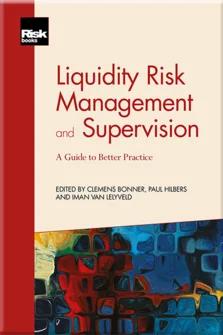Liquidity Regulation, the 2007-9 Crisis and the Regulatory Response
Introduction to ‘Liquidity Risk Management and Supervision’
Liquidity Regulation, the 2007-9 Crisis and the Regulatory Response
Sources of Liquidity Risk: Theory and Empirical Evidence
The Process of Liquidity Supervision
How to Implement ILAAP: Lessons Learned at Rabobank
Liquidity Risk Management Strategy and Tolerance
Liquidity Buffer Management and Banks’ Counterbalancing Capacity
Bank-Level Liquidity Stress-Testing
Contingency Funding Plans
Liquidity Transfer Pricing
Intraday Liquidity Risk Management
Putting Liquidity Risk Management into a Wider Context
Macroprudential Liquidity Stress Tests
A Simple Macroprudential Liquidity Buffer
Bank capital and liquidity are two intrinsically linked concepts and important mitigators of the risks included in banks’ core business. While capital is part of banks’ liabilities and therefore a source of funding, liquid assets appear on the other side as a use of funding. Capital can absorb losses; liquid assets can be used to compensate the risk of other funding sources drying up. Although they are usually considered separately, bank capital and liquidity interact in a number of direct and indirect ways or, as Goodhart (2009) puts it: “An illiquid bank can rapidly become insolvent, and an insolvent bank illiquid”.
It should therefore not come as a surprise that the then chairman of the Basel Committee on Banking Supervision (BCBS), George Blunden, stated at its initial meeting in 1975 that the Committee’s aim is to ensure adequate capital and liquidity levels of the main international banks. Indeed, when the BCBS was in the process of defining the first globally harmonised capital standards, it also attempted to harmonise liquidity regulation. However, while the BCBS succeeded in introducing global capital standards, known as the Basel Accord or Basel I in 1988, it
Copyright Infopro Digital Limited. All rights reserved.
As outlined in our terms and conditions, https://www.infopro-digital.com/terms-and-conditions/subscriptions/ (point 2.4), printing is limited to a single copy.
If you would like to purchase additional rights please email info@risk.net
Copyright Infopro Digital Limited. All rights reserved.
You may share this content using our article tools. As outlined in our terms and conditions, https://www.infopro-digital.com/terms-and-conditions/subscriptions/ (clause 2.4), an Authorised User may only make one copy of the materials for their own personal use. You must also comply with the restrictions in clause 2.5.
If you would like to purchase additional rights please email info@risk.net











